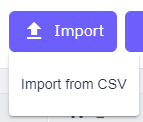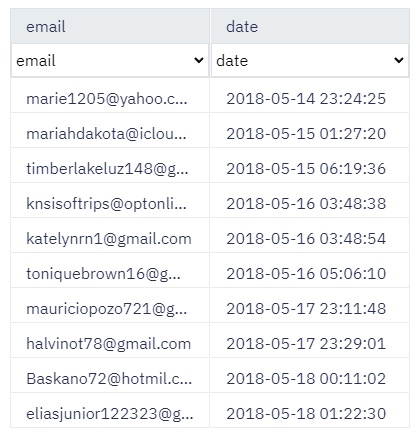Twidget enables seamless import of data from a CSV file into your database. Follow the steps below to successfully import a CSV file.
-
Initiate the Import:
Click on the Import button within the table toolbar.
Select Import from CSV from the dropdown.

Open Import Dialog:
A new import dialog will appear.
Click on the Choose File button and select your CSV file from your local storage.

Preview CSV Data:
After selecting your file, you will be able to preview the first 10 rows of your CSV.
This provides an opportunity to ensure your data looks correct before importing.

Map CSV Columns to Table Fields:
The dialog will automatically map CSV column headings to table fields if there is a match.
Any headings that do not match an existing table field need to be manually mapped by selecting the appropriate table field.
Headings not mapped or duplicated will be highlighted in red.

Note: You cannot import fields that are of type
ListorObject.
Create Missing Columns:
Complete the Import:

Automatic vs. Manual Mapping: While Twidget automatically maps matching column headings, ensure to review each mapping for accuracy.
Field Restrictions: Remember, List and Object fields cannot be imported. All other fields should be correctly mapped.
Pre-import Preparation: Verify and create any columns that are not currently existing in your table to make sure data is not lost during the import.
Generate CRUD Endpoints
With Twidget, you can efficiently generate CRUD (Create, Read, Update, Delete) endpoints for your database tables upon their creation. This functionality is designed to streamline the development process and ensure that essential API operations are readily available. Enabling CRUD Endpoints. 1. Crea...
Database Basics
Twidget offers a comprehensive database solution for all workspaces. Here's an overview of how databases are structured and managed within Twidget: Database Structure. 1. Tables: A database may contain multiple tables. Each table stores data in a structured format. 2. Fields: Tables consist of field...
Adding Database Table Rows
In Twidget, you can easily add new entries (rows) to your database tables. This feature allows you to expand your data dynamically without the need for complex coding. This document provides a step-by-step guide on how to add rows to your database tables. Adding a New Entry to a Table. To add a new ...
Filter Data
In Twidget, you can easily filter and sort data within the database tables view. This allows you to refine and manipulate the data as needed. Below are the steps and options available for filtering and sorting data. Filtering Data. To filter data: 1. Click on the Filter Button: In the table toolbar,...
Table Field Types
Each table column in Twidget has a data type. The available data types are: - Text - Number - Boolean - Date - Object Field Type Adherence. Data added to the table should adhere to the column's field type. When you manually enter data via the web application, the value editor will use the input type...